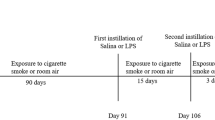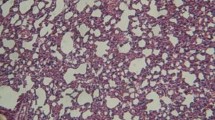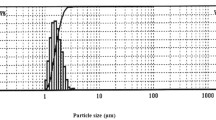Abstract
Chronic obstructive pulmonary disease (COPD) is a progressive and irreversible chronic inflammatory disease associated with the accumulation of activated T cells. To date, there is little information concerning the intrinsic association among Th17, Tc17, and regulatory T (Treg) cells in COPD. The objective of this study was to investigate the variation of lungs CD4+Foxp3+ Treg cells and IL-17-producing CD4 and CD8 (Th17 and Tc17) lymphocytes in mice with cigarette-induced emphysema. Groups of mice were exposed to cigarette smoke or room air. At weeks 12 and 24, mice were sacrificed to observe histological changes by HE stain. The frequencies of Th17 (CD4+IL-17+T), Tc17 (CD8+IL-17+T), and Treg (CD4+Foxp3+T) cells in lungs from these mice were analyzed by flow cytometry. The mRNA levels of orphan nuclear receptor ROR γt and Foxp3 were performed by real-time quantitative polymerase chain reaction. The protein levels of interleukin-17 (IL-17), IL-6, IL-10, and transforming growth factor-beta (TGF-β1) were measured by enzyme-linked immunosorbent assay. Cigarette smoke caused substantial enlargement of the air spaces accompanied by the destruction of the normal alveolar architecture and led to emphysema. The frequencies of Th17 and Tc17 cells, as well as the expressions of IL-6, IL-17, TGF-β1, and ROR γt were greater in the lungs of cigarette smoke (CS)-exposed mice, particularly in the 24-week CS-exposed mice. The frequencies of Treg cells and the expressions of IL-10 and Foxp3 were lower in CS-exposed mice compared to control group. More important, the frequencies of Tregs were negatively correlated with Th17 cells and with Tc17 cells. Interestingly, a significant portion of the cells that infiltrate the lungs was skewed towards a Tc17 phenotype. Our findings suggest the contribution of Th17, Tc17, and Treg cells in the pathogenesis of COPD. Rebalance of these cells will be helpful for developing and refining the new immunological therapies for COPD.








Similar content being viewed by others
References
Decramer, M., W. Janssens, and M. Miravitlles. 2012. Chronic obstructive pulmonary disease. Lancet 379(9823): 1341–1351.
Brusselle, G.G., G.F. Joos, and K.R. Bracke. 2011. New insights into the immunology of chronic obstructive pulmonary disease. Lancet 378(9795): 1015–1026.
MacNee, W. 2011. Aging, inflammation, and emphysema. American Journal of Respiratory and Critical Care Medicine 184(12): 1327–1329.
Hou, J., Y. Sun, Y. Hao, et al. 2013. Imbalance between subpopulations of regulatory T cells in COPD. Thorax 68(12): 1131–1139.
Cosio, M.G., and J. Majo. 2002. Inflammation of the airways and lung parenchyma in COPD: role of T cells. Chest 121(5 suppl): 160S–165S.
Hodge, G., J. Nairn, M. Holmes, P.N. Reynolds, and S. Hodge. 2007. Increased intracellular T helper 1 proinflammatory cytokine production in peripheral blood, bronchoalveolar lavage and intraepithelial T cells of COPD subjects. Clinical and Experimental Immunology 150(1): 22–29.
Weaver, C.T., and R.D. Hatton. 2009. Interplay between the TH17 and Treg cell lineages: a (co-) evolutionary perspective. Nature Reviews. Immunology 9(12): 883–889.
Bettelli, E., T. Korn, and V.K. Kuchroo. 2007. Th17: the third member of the effector T cell trilogy. Current Opinion in Immunology 19(2): 652–657.
Steinman, L. 2007. A brief history of T(H)17, the first major revision in the T(H)1/T(H)2 hypothesis of T cell-mediated tissue damage. Nature Medicine 13(2): 139–145.
Kondo, T., H. Takata, F. Matsuki, and M. Takiguchi. 2009. Cutting edge: phenotypic characterization and differentiation of human CD8+ T cells producing IL-17. Journal of Immunology 182(4): 1794–1798.
Ohkura, N., Y. Kitagawa, and S. Sakaguchi. 2013. Development and maintenance of regulatory T cells. Immunity 38(3): 414–423.
von Boehmer, H. 2005. Mechanisms of suppression by suppressor T cells. Nature Immunology 6(4): 338–344.
Korn, T., E. Bettelli, M. Oukka, et al. 2009. IL-17 and Th17 cells. Annual Review of Immunology 27: 485–517.
Henriques, A., L. Inês, M. Couto, et al. 2010. Frequency and functional activity of Th17, Tc17 and other T-cell subsets in systemic lupus erythematosus. Cellular Immunology 264(1): 97–103.
Vargas-Rojas, M.I., A. Ramírez-Venegas, L. Limón-Camacho, et al. 2011. Increase of Th17 cells in peripheral blood of patients with chronic obstructive pulmonary disease. Respiratory Medicine 105(11): 1648–1654.
Kalathil, S.G., A.A. Lugade, V. Pradhan, et al. 2014. T-regulatory cells and programmed death 1+ T cells contribute to effector T-cell dysfunction in patients with chronic obstructive pulmonary disease. American Journal of Respiratory and Critical Care Medicine 190(1): 40–50.
D’hulst, A.I., K.Y. Vermaelen, G.G. Brusselle, G.F. Joos, and R.A. Pauwels. 2005. Time course of cigarette smoke-induced pulmonary inflammation in mice. European Respiratory Journal 26(2): 204–213.
Macdonald, G., N. Kondor, V. Yousefi, et al. 2004. Reduction of carboxyhaemoglobin levels in the venous blood of cigarette smokers following the administration of carbogen. Radiotherapy and Oncology 73(3): 367–371.
Saetta, M., R.J. Shiner, G.E. Angus, et al. 1985. Destructive index: a measurement of lung parenchymal destruction in smokers. American Review of Respiratory Disease 131(5): 764–769.
Thurlbeck, W.M. 1967. Measurement of pulmonary emphysema. American Review of Respiratory Disease 95(5): 752–764.
Vermaelen, K.Y., I. Carro-Muino, B.N. Lambrecht, et al. 2001. Specific migratory dendritic cells rapidly transport antigen from the airways to the thoracic lymph nodes. Journal of Experimental Medicine 193(1): 51–60.
Vosshenrich, C.A., and J.P. Di Santo. 2001. Cytokines: IL-21 joins the gamma(c)-dependent network? Current Biology 11(5): R175–R177.
Barnes, P.J., and M.G. Cosio. 2004. Characterization of T lymphocytes in chronic obstructive pulmonary disease. PLoS Medicine 1(1), e20.
Chang, Y., L. Al-Alwan, S. Alshakfa, et al. 2014. Upregulation of IL-17A/F from human lung tissue explants with cigarette smoke exposure: implications for COPD. Respiratory Research 15: 145.
Duan, M.C., Y. Huang, X.N. Zhong, and H.J. Tang. 2012. Th17 cell enhances CD8 T-cell cytotoxicity via IL-21 production in emphysema mice. Mediators of Inflammation 2012: 898053.
Zhang, X., H. Zheng, H. Zhang, et al. 2011. Increased interleukin (IL)-8 and decreased IL-17 production in chronic obstructive pulmonary disease (COPD) provoked by cigarette smoke. Cytokine 56(3): 717–725.
Duan, M.C., X.N. Zhong, Y. Huang, Z.Y. He, and H.J. Tang. 2011. The expression and mechanisms of interleukin-17 in CD(8)(+) T cells of mice with cigarette smoke-induced emphysema. Chinese Journal Internal Medicine 50(9): 776–780.
Zhou, H., W. Hua, Y. Jin, et al. 2015. Tc17 cells are associated with cigarette smoke-induced lung inflammation and emphysema. Respirology 20(3): 426–433.
Huber, M., S. Heink, H. Grothe, et al. 2009. A Th17-like developmental process leads to CD8(+) Tc17 cells with reduced cytotoxic activity. European Journal of Immunology 39(7): 1716–1725.
Duan, M.C., H.J. Tang, X.N. Zhong, and Y. Huang. 2013. Persistence of Th17/Tc17 cell expression upon smoking cessation in mice with cigarette smoke-induced emphysema. Clinical and Developmental Immunology 2013: 350727.
Demoor, T., K.R. Bracke, G.F. Joos, and G.G. Brusselle. 2010. Increased T-regulatory cells in lungs and draining lymph nodes in a murine model of COPD. European Respiratory Journal 35(3): 688–689.
Li, X.N., X. Pan, and D. Qiu. 2014. Imbalances of Th17 and Treg cells and their respective cytokines in COPD patients by disease stage. International Journal Clinical and Experimental Medicine 7(12): 5324–5329.
Zhou, L., M.M. Chong, and D.R. Littman. 2009. Plasticity of CD4+ T cell lineage differentiation. Immunity 30(5): 646–655.
Koenen, H.J., R.L. Smeets, P.M. Vink, et al. 2008. Human CD25highFoxp3pos regulatory T cells differentiate into IL-17-producing cells. Blood 112(6): 2340–2352.
McNally, A., M. McNally, R. Galea, R. Thomas, and R.J. Steptoe. 2014. Immunogenic, but not steady-state, antigen presentation permits regulatory T-cells to control CD8+ T-cell effector differentiation by IL-2 modulation. PLoS One 9(1), e85455.
Sun, J.C., M.A. Williams, and M.J. Bevan. 2004. CD4+ T cells are required for the maintenance, not programming, of memory CD8+ T cells after acute infection. Nature Immunology 5(9): 927–933.
Acknowledgments
This work was supported by the National Natural Science Foundation of China Grant 81360011 and 81460009, by Guangxi Natural Science Foundation of China Grant 2013GXNSFAA019256, and by Nanning Science and Technology Program, China (No. 20143161 and No.20153088).
Author information
Authors and Affiliations
Corresponding author
Ethics declarations
All experimental protocols were approved by the Ethical Committee for Animal Research of Guangxi Medical University.
Conflict of Interests
The authors declare that they have no conflict of interests.
Rights and permissions
About this article
Cite this article
Duan, MC., Zhang, JQ., Liang, Y. et al. Infiltration of IL-17-Producing T Cells and Treg Cells in a Mouse Model of Smoke-Induced Emphysema. Inflammation 39, 1334–1344 (2016). https://doi.org/10.1007/s10753-016-0365-8
Published:
Issue Date:
DOI: https://doi.org/10.1007/s10753-016-0365-8




